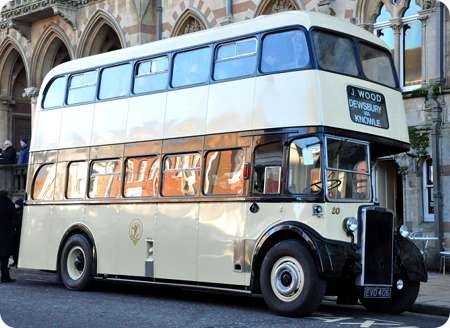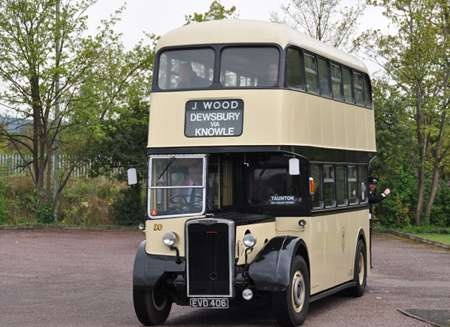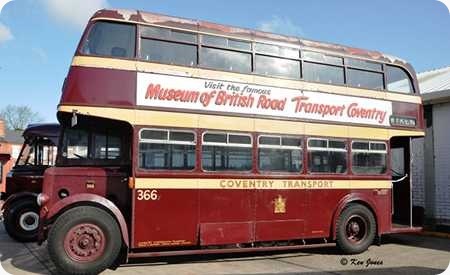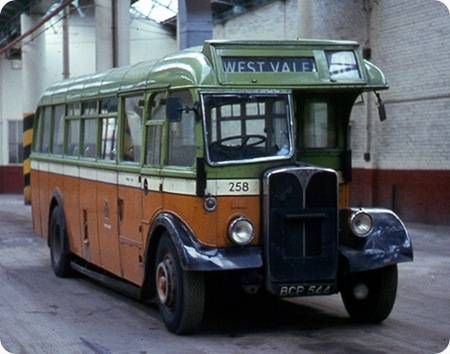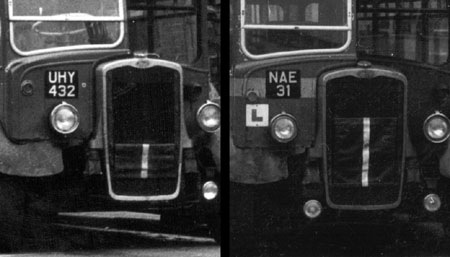J Wood & Sons – Crossley DD42 – EVD 406 – 20
J Wood & Sons (Mirfield)
1949
Crossley DD42/7
Roe H56R
Here is a view of J Wood & Sons of Mirfield preserved Crossley DD42/7 bought in 1953 from Baxter’s of Airdrie where it was delivered new in 1949. She sports a Roe H56R body from either 1954 or 55 there seems to be conflicting information on the actual date, can anyone confirm? New 1949 rebodied 1954/5, five or six years does not seem all that long, is there a story behind that, and does anyone know what the original body was? She is seen outside Winchester Guildhall on 1 January 2010, visiting the King Alfred Running Day.
Photograph and Copy contributed by Pete Davies
21/12/12 – 07:33
Just for information. The 2013 King Alfred Running Day will, as usual, be on New Year’s Day. Sometimes, the event is moved, but no disruption for this coming one. The restored Leyland Olympic should be back in service and one of the members is hoping to have his 1930’s Paris Renault on duty.
Pete Davies
21/12/12 – 07:34
I have some information about the Crossley of Joseph Wood. The original body was built by Scottish Aviation. Two elderly coaches were traded in to Comberhill Motors of Wakefield to purchase the bus. This was the first double decker for the firm. Mr Colin Wood Josephs son related the facts to me. He was serving in the army in Korea when he received an angry letter from his father to tell him that on its first test it had failed due to bodywork defects. Colin suggested that they had the bus rebodied. At the time Yorkshire Woollen were having their wartime Guy Arabs rebodied so it was arranged that the Crossley would have similar bodywork. In 1954 the company scrapped the body and the head driver Mr Sam Land drove the chassis from Mirfield to Crossgates. On its return it entered service and was used on the joint service from Mirfield to Dewsbury alongside J J Longstaff and Yorkshire Woollen. For the next twenty years or so it went through two engines on the service its only escape was when Huddersfield Town Football club was playing at home when it was used on the excursion to the ground. Eventually the day came when the Crossley was due for withdrawal and so the ex Leyland Atlantean demonstrator KTD 551C was purchased. The Crossley was parked up against the garage and eventually became a tyre store. Colin had always wanted to preserve the bus and for the next few years he worked on the bus and had it reupholstered. On completion the bus looked splendid and one Sunday he invited friends and former employees and the bus made two commemorative journeys. Then the bus was kept at Keighley Bus Museum and was rallied frequently. Eventually it was decided to sell the bus and it was sold to Quanstock Motor Services and I read in Preserved Bus that the vehicle was for sale. If I win the Euro Millions Lottery it will be the first thing on my shopping list!!!
Philip Carlton
21/12/12 – 07:35
This bus is currently up for sale at Quantock Motor Services and they have it being re-bodied in 1952
Andrew
21/12/12 – 07:36
Beautiful – and beautifully preserved – bus. As a Roe man, my gut instinct says 1954 rather 1955. The upper deck would have been slightly different, but the archaic five bay lay-out muddies the waters. [I don’t have documentary proof, just instinct.]
David Oldfield
21/12/12 – 07:38
Pete, you have raised an interesting question about the original body on this bus, and, surprisingly, the comprehensive ‘Crossley’ book by Eyre, Heaps and Townsin does not give a specific answer as far as I can find. The authors do make reference to five single deck SD42s bought by Joseph Wood, and then go on to state that Wood "acquired a second hand DD42 which it had fitted with a new Roe body", but neither the previous owner nor the original body are identified. The Scottish agent for Crossley was the Scottish Commercial Motor Co. of Glasgow, and it made the bodies itself on a number of its sales, but some were fitted with other makes of bodywork, including lowbridge examples by Roe. However, the following site www.sct61.org.uk/ confirms that the original body was, indeed, a Scottish Commercial product that was superseded by the current excellent Roe body in 1954. Clearly, some, at least, of the Scottish Commercial bodies must have been decidedly suspect to have given a life of only five years. Most of the wartime utilities managed rather better than that.
Roger Cox
21/12/12 – 10:33
Thank you, gents, for your comments on the origin of this bodywork. A fascinating read!
Pete Davies
21/12/12 – 12:48
I would say that the earliest the body dates from is 1954. I am basing this on deliveries to Leeds in that period all of which had deeper windows on both decks. By the arrival of the 1954 AEC Regents these were much shallower as seen here. However the bus is still an absolute gem and ideally should be repatriated north.
Chris Hough
21/12/12 – 12:49
I’m in complete agreement with David O, that it would have looked so much better with the Roe four and a quarter bay body, but I’m not sure if that style was available in 7ft 6in width, which this vehicle was. Around the same time, J W Moseley of Barugh Green, Barnsley had an ex-Sheffield utility Daimler rebodied with exactly the same style of Roe body.
Chris Barker
21/12/12 – 13:47
You may want to add this picture to the current discussion as it shows the vehicle from the front, and no reflections in the windows. Taken by myself at Taunton Railway Station on 1/5/10 during Quantock Motors running day,
Ken Jones
21/12/12 – 13:48
Chris The 4 and a quarter bay body was widely available so to speak from Roe Leeds standardised on 4 bays the half bay was (blanked off) from 1948 onwards and I think this was the Roe standard. One thing Roe often did for smaller operators was to tack their buses onto the end of a larger order which meant they got the same style of body but with a bit off the cost.
Chris Hough
23/12/12 – 07:19
It has to be said – a great looking vehicle even if it’s an ACV Crossley. Given the location of its owner, given the weather and, prior to smokeless zones, the output from household fires and woollen mill chimneys, the choice of colour scheme must have kept the bus washers busy.
Phil Blinkhorn
31/12/12 – 07:02
The Roe body dates from 1955 being completed on the 6th April that year.
Andrew Beever
01/01/13 – 11:33
The first photograph on this link shows EVD 406 prior to the 1955 Roe body being fitted www.jsh1949.co.uk/
Andrew Beever
18/02/13 – 08:29
Stephen Morris was driving this vehicle in service today [17/2/13] at the Hanley event. He expects to be driving it in service at the Kirkby Stephens event over Easter
Ken Jones
02/03/13 – 07:05
Was delighted to see this bus at Hanley but the engine was running flat no guts at all. Not sure what has happened to it recently but the last time I rode on it in 1999 at Keighley it had plenty of power then. Unfortunately the Hanley performance caused the running out in conversation all the usual Crossley negative traits. Shame after the effort myself with DBN 978 and the Birmingham 2489 Group have made to dispel this image!
Ralph Oakes-Garnett
14/03/13 – 16:06
A quick question if I may, when did Woods actually finish??
Peter Abel
15/03/13 – 08:33
The question of when Woods finished is around 1985 I forget the actual date. What happened is that they sold out to Abbeyways of Halifax who consolidated the Mirfield operation as Go Big Ltd and operations continued sometimes using buses from the Hyndburn hire fleet both double and single deckers but a bizarre purchase was a Leyland Leopard with an Alexander body that had once been a Leyland demonstrator abroad that operated on a Q plate. I remember that it had the destination for the Mirfield to Dewsbury service painted on the destination glass. Later on selling this bus the new owner had it rebodied by Plaxton.Eventually Abbeyways wound up the Mirfield operations and the depot at Lee Green Mirfield was sold to Ron Lyles who moved there from Batley. Later he moved his operations back to Batley and the depot was pulled down and Old Peoples flats were built on the site.
Philip Carlton
15/03/13 – 11:11
Thanks very much for info Philip. I will see if there’s anything in ‘Buses’ for that year.
Peter Abel
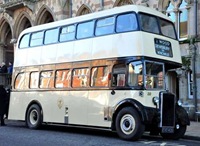 Vehicle reminder shot for this posting
Vehicle reminder shot for this posting
18/06/15 – 10:48
I believe this bus is now in the care of the Dewsbury Bus Museum. It turned up as a ‘special guest’ at their March open day, still in pristine condition. Unfortunately it was parked in a corner and my photo did not do it justice.
Tim Jackson
Quick links to the - Comments Page - Contact Page - Home Page
